For the casting job I have coming up I want to use Monotype medium alloy (74/10/16% Pb/Sn/Sb) rather than the softer Linotype alloy (84/4/12%) currently in the pot, which I was using to cast spacing.
To do this, I got four ingot moulds ready on a cart, mostly covered by galley trays to protect against any pops and splashing that might occur if the hot metal finds some moisture trapped in the surface of the mould.
I fired up the pot, and once it was well melted I removed the pump, fluxed and cleaned the surface, turned off the heat, and ladled the type metal into the ingot moulds. As I neared the bottom of the pot I had to switch to progressively smaller ladles, and left a small puddle of metal in the well in the bottom of the pot. While things were still hot, I also used a screwdriver to loosen some of the mush that was stuck between the heating elements and the walls of the pot. This mush is a mix of molten metal and oxides which contains enough oxide powder that it doesn’t just flow to the bottom of the pot.
Once the pot was cold again I scooped out most of the loosened mush (now hard again because the metal holding it together had solidified) and pulled out the disk of metal hardened in the well.
The cart holding the moulds wasn’t level so one of the moulds overflowed into the cart. The galley pans covering things meant I didn’t see this happening. In any case, I ended up with four ingots, one puddle from the spillage and the disk from the well.
To do a better job of removing more of the hardened mush around the element, I removed the pump support arms which otherwise block access to the rear element and the area near the electrical connections.
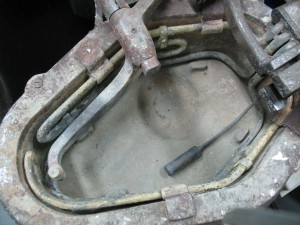
All cleaned out and the pump supports re-installed. I was tempted to vacuum out the rest of the dust but decided that anything loose enough to vacuum would also be loose enough to float to the top when the pot was refilled.
One ongoing problem I have had with my pot is that the end of the front element, where it wraps around the nozzle area of the pot, is too high. To keep it submerged I have to keep the pot absolutely brimfull with metal, which makes for more frequent spills, and also makes fluxing and cleaning the metal more difficult. Running with a lower metal level in the pot, leaving part of the element exposed, creates a hot spot in the element where it might burn out prematurely, and forms an extra-hot surface exposed to the air which encourages faster oxidation of the metal.
To force this part of the element down, I put a small piece of 1/8″-thick steel under the nearest retainer clip, which pushed the end of the element down about ¼″ which will make all the difference in the world.
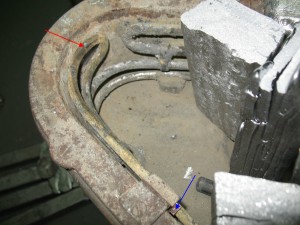
The red arrow points to the section of the element that was too high. The blue arrow indicates the shim I installed.
To refill the pot, I removed the long pump support arm which holds the nozzle end so that I could pack more broken ingot pieces into the pot. Refilling a pot leaves may sections of heating element out of contact with the metal and thus running hotter than normal, which might reduce the element life, so you want the pot as full as possible.
I tried something new here. I have some welding blankets, made of woven glass fibre, which I folded and placed over the pot while melting the ingots. This serves several purposes:
- It limits air flow around the molten metal and thus reduces oxidation
- It generally retains heat in the pot and speeds the melting process
- The heat from the parts of the elements not in contact with the metal still contribute to melting rather than radiating into the room
- If a piece of ingot topples while melting, any splashing that occurs will be contained by the blanket
I don’t know how much of a difference the blankets made, but when I came back to the caster I found a pot of nice clean molten type metal. I had also judged the amount of metal just about right: the elements were just submerged, and there was enough spare space that there was no need to remove excess metal when I put the pump back on.

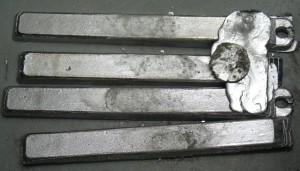
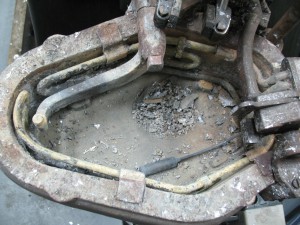
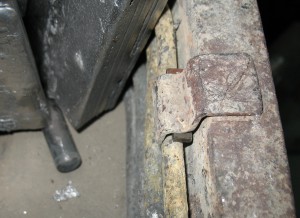
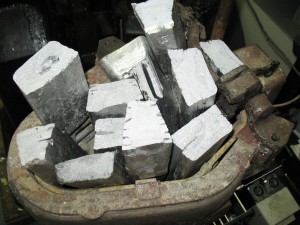
Not bad. Emptying a pot is also a good opportunity to check and correct the pump/nozzle alignment, especially when changing the pump. It’s much less stressful to do when cold :).
When filling the pot, I use old type. The gaps between sorts are narrow and the metal is in contact with heaters.
And by the way, here at the Book Art Museum we have a large composition (a.k.a. type&rule) caster which is partially stripped and acts as a spare parts donor, and we use its melting pot for making ingots. We sometimes find some incomplete cases of old foundry type, which contains much antimony… and we can melt it with equal amount of Linotype alloy. The result is several hundred kilos of Monotype ingots, as well as lots of smoke from burning dust ;).
Christophe,
As you may have read in older posts I had a rough time with nozzle alignment which turned out to be due to a worn nozzle. When properly aligned, it leaked horribly, and when adjusted to not leak, it spent too much time in contact with the mould and froze up too often!
I actually have enough spare parts to make up a standalone Monotype melting pot, but I already have a Nolan Supercaster (stereotype caster) which I can use for remelting and ingotting purposes.
I don’t really have a ready supply of old foundry type to sacrifice. I suppose I could offer to buy some from Don Black at some premium over what he gets from the scrap dealers. I still don’t have any good way of testing the alloy though. This isn’t a problem if I’m casting for my own use, but if I’m casting type to sell I would like to know the characteristics of the metal I’m using.
To refill pot use old type, it touches the element for the most part, but keep an eye on it, top up, when it is partly melted you can put larger ingot parts in.